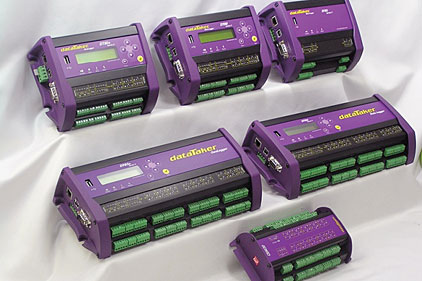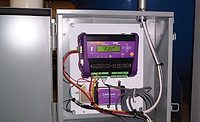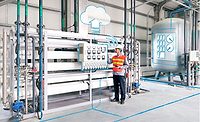Intelligent Data Logging Operations

With advances in technology and computing power, modern data loggers can dramatically reduce the amount of time and effort required to extract critical information. These "intelligent" data loggers incorporate a number of features that allow them to go well beyond the functionality of traditional data loggers to help home in on the information the user is looking for. The key is separating the raw data from the information it contains, which is what the user is really after.
Gleaning Information Intelligently
One intelligent data logging feature is flexible scheduling that allows the measurement and recording of data to be tailored to each specific application. In many instances, there are some parameters of interest that may change slowly, such as the temperature of a large furnace or the level in a tank. Other parameters may change much more rapidly, such as the pressure or flow rate in a fluid line. By allowing multiple sample rates, intelligent data loggers can be configured to match the sample interval to the maximum rate of change, eliminating redundant data. Other sampling techniques include adjustable or adaptive sampling schedules that allow the data logger to change the sample rate or the number of inputs to be measured based on an external event or the value of a measured parameter. This allows the data logger to only record data when it's meaningful. Often, it's not the individual data points that are important, but rather the overall behavior over some period of time. Simple statistical techniques can be used to reduce the mountain of data down to a few salient point values that convey the same information. Intelligent data loggers can measure hundreds of data points of a specified period of time and then report information such as the minimum and maximum values, the average and standard deviation of the measured points, and even the date and time of minimum or maximum values. Some loggers even include the ability to bin data into histograms to provide a clear picture of the distribution of measured value over some period of time. For repeating cyclic data, loggers such as the dataTaker DT800 incorporate software that implements the ASTM 1049-85 Rainflow cycle counting method. This is an internationally accepted technique to monitor strain-stress hysteresis for structural fatigue. It allows literally thousands of measured data points to be reduced down to 10-20 values that capture all of the information.
Today’s intelligent loggers also incorporate the ability to perform calculations on the measured values. This can be as simple as scaling linear sensor outputs to meaningful values or as complex as applying a 5th order polynomial to convert a non-linear input into useful values. Local integer and floating point variables allow for very complex calculations using standard arithmetic, trigonometric, relational, and logical operators as well as conditional calculations.
Finally, a very powerful feature of intelligent data loggers is flexible alarm programming. While many data loggers allow simple alarms based on whether a value is above or below a preset limit, intelligent data loggers provide greatly expanded capabilities including alarms that are based on the value of multiple inputs, rate of change of an input, time, calculated values, or a combination of all of these. These alarms can do much more than simply throw up a flag − they can enable or disable other measurements, turn one or more outputs on or off, send an email or text, or change the operating mode of the logger.
By using the capabilities of a modern, intelligent data logger, it is possible to minimize the amount of raw data that must be manually analyzed and to maximize actionable data that contains the essential information that the user was after when they installed the logger. Alarms can be configured to provide immediate notification of out of limit conditions while minimizing the number of false trips.
Monitoring Plant Operations and Processes
One very common application of data loggers is to monitor equipment or process performance in manufacturing plants. For example, one customer wanted to monitor the operation of a welding line. The line had four welding cells, each with four stations. Previously, there was no easy method to capture usage information other than to count the number of parts being produced. A dataTaker DT85 data logger was installed with current sensors for each of the welding stations. Then a program was created on the data logger to sample every half second and record whenever current was flowing, indicating that a particular station was active. While it would be possible to retrieve the data and chart out the operation for each cell, utilizing the features of the data logger allowed the user to create a simple dashboard that provided an instant view of the operation. Internal counters monitored the total time each cell was active as well as the total elapsed time during the shift. From this, a simple ratio showed the percentage of uptime. If a particular station was not in operation for more than 20 minutes, it was assumed to be down and an alarm was generated. By utilizing the real-time clock functions in the logger, the counters were reset at the end of the shift to prepare for the next group of operators.
Another very common use of data loggers is to track the level of various types of materials in storage tanks. The data can then be retrieved and analyzed to determine usage information. In some cases, simple level alarms may be implemented to provide a warning if the level gets too low or high. These capabilities can be enhanced by using the ability of the logger to calculate the rate of change of the level. A sudden increase or decrease in the rate of change can be indicative of a problem even if the level is still within limits. One customer has even implemented a JIT inventory management system using the data logger to alert the supplier when re-supply is needed.
Using Intelligent Data Loggers with PLCs
Often data loggers are used alongside programmable controllers (PLCs) either to provide a backup history of the operation of the controller or to troubleshoot operating anomalies in the controller. By continuously tracking the inputs to the controller as well as the outputs of the controller, the logger can quickly identify unusual behavior. The ability of intelligent loggers to set up alarms based on multiple inputs (both analog and digital) and different combinations of inputs allow the quick diagnosis of the sequence of events leading up to the failure. In some cases, a data logger can even take the place of a small PLC. Combining the flexible measurement capability and digital outputs with the on-board intelligence to process information and take action based on readings, allows a data logger to both monitor and control small processes or machines. A recent example is the control of a small wastewater treatment plant. Initially, the logger was installed to monitor the operations of the plant and it was found that during heavy rains, groundwater seeping into the system was overloading the aeration tanks and forcing sludge out into the filter beds, contaminating them. The data logger program was enhanced to control the operation of blower cycles during heavy rains to allow the sludge to settle out before it could be washed out of the system.
lnternet-Enabled Data Logging Applications
Additionally, the latest generation of intelligent data loggers offers internet connectivity to enable a whole new class of applications. These devices can publish real-time or historical data via built-in web servers, send email and SMS messages, or receive SMS messages and initiate actions.
In the past, if engineers wanted to publish data collected by the device, it had to be taken back to a computer and processed there, but nowadays, data loggers such as those from dataTaker incorporate an internal web server. Using a standard web browser on a PC (or even a PDA) allows a user to retrieve the current measured values, status, alarm, and error information. An API that includes a library of SSI directives allows the user to develop a customized web page that can then be stored in the logger. For example, imagine a data logger connected to a weather station that not only records meteorological data but also publishes a web page showing the current conditions all on its own.
By combining an intelligent data logger with an SMS compatible modem, it's possible to build a system that can transmit alarm messages that not only communicate the nature of the alarm but actual measured values. This allows the person receiving the message to determine both the nature and the severity of the condition and decide if urgent action is needed or if it's a minor issue that can be dealt with in due course. Conversely, the data logger can accept SMS messages and take action based on them. In the case of an alarm, the data logger could be instructed to run a special diagnostic test to collect data that is not normally recorded and relay this back to the user to help identify the nature of the problem. Alternatively, the user could send a message to the logger to activate or deactivate an output that controls another piece of equipment.
More than Just Recording
Modern data loggers can do much more than simply record analog and digital signals as did previous generations of these devices. Enhanced processing power combined with predefined math, statistical and alarm functions and flexible programming interfaces, allow them to process measured data locally, reduce the volume of data being stored, and generate actionable information. Intelligent data loggers can also make complex conditional decisions based on incoming data, execute simple control functions, and generate alarm and email messages based on user-defined criteria. The latest generation of products even includes web servers making the data available to a much wider audience via standard tools. By using these capabilities, users can dramatically improve productivity by reducing the time and effort required to get the information they need to do their job efficiently.
For further information, visit www.DataLoggerInc.com.
Looking for a reprint of this article?
From high-res PDFs to custom plaques, order your copy today!







